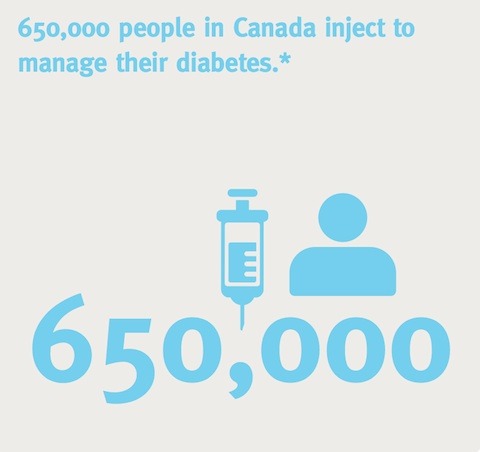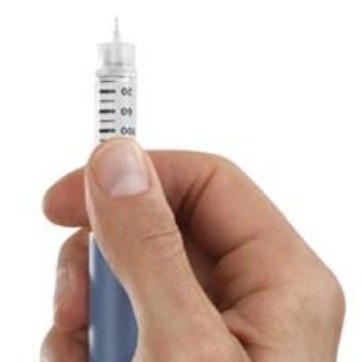
Injecting insulin is a normal part of caring for type 2 diabetes
- It’s not your fault. Diabetes is a disease that may worsen over time. This means that you may not be able to control your blood glucose with diet, exercise and/or pills alone. In fact, one study showed that after 6 to 10 years of having Type 2 diabetes you may only have 25% of normal insulin production2 making your diabetes more difficult to control – regardless of how hard you try!
- Insulin has the greatest blood glucose lowering effect of all diabetes medications.10 Used properly, insulin can help you to achieve control of your diabetes
- Insulin regimens should be tailored to fit your lifestyle. People take insulin anywhere from once to 4 times/day. The number of injections or the amount of insulin that you take per day does not mean that your diabetes is more serious or “bad.”

Did you know?
Injections are easier and more comfortable than you might think
Most people with diabetes use an insulin pen device to inject insulin. Pens offer an easy way to deliver an exact dose. Pens can either be reusable or disposable.
With the recent understanding of injection technique and depth of injection, shorter needles are now recommended for all people living with diabetes.7

When it’s time to start insulin, your diabetes educator will take the time to teach you how to inject properly to ensure that you receive the most comfortable injection experience possible.

You’re not alone
People that already inject insulin, wish that they had started sooner
If you need insulin please don’t be scared. When I was told I had to go on insulin I cried I was that scared. I have been on insulin now for 4 months 1 needle a day in the morning at 32 units. IT DOES NOT HURT, my doctor gave me a sheet that outlines the body areas where you give your shots. I am not afraid anymore and my diabetes is under control finally. Your pen comes in a case with a place for your needle tips; you can carry it anywhere from work to school ... anywhere. If insulin is going to save your life don’t wait.
*BD Data on file.
1 Alberti G. The DAWN (Diabetes Attitudes, Wishes, and Needs) study. Pract Diabetes Int19:22–24, 2002. 2 Diabetes Control and Complications Trial Research Group: The effect of intensive treatment of diabetes on the development and progression of long-term complications in insulin-dependent diabetes mellitus. N Engl J Med 329:977–986, 1993. 3 Valensi P, et al. The IMPROVE(TM) study – a multinational, observational study in type 2 diabetes: baseline characteristics from eight national cohorts. Int J Clin Pract 2008;62(11):1809–19. 4 Harris SB, Ekoe JM, Zdanowicz Y, et al. Glycemic control and morbidity in the Canadian primary care setting (results of the diabetes in Canada Evaluation Study). Diabetes Res Clin Pract 2005;70:90e7. 5 Braga M, et al. Treatment gaps in the management of cardiovascular risk factors in patients with type 2 diabetes in Canada. Can J Cardiol 2010;26(6):297-302. 6 Leiter LA, Berard L, Bowering K, et al. Type 2 diabetes mellitus management in Canada: Is it improving? Can J Diabetes 2013: in press. 7 Berard L, et al. FIT Forum for Injection Technique Canada. Recommendations for Best Practice in Injection Technique. October 2011. 8 Aronson R. The Role of Comfort and Discomfort in Insulin Therapy. Diabetes Technology & Therapeutics. April 2012;14(8):1-7 9 Polinski JM, et al. Barriers to Insulin Progression Among Patients With Type 2 Diabetes. The Diabetes Educator 2013;39:53. 2013 10 Canadian Diabetes Association 2008 Clinical Practice Guidelines for the prevention and Management of Diabetes in Canada. Can J Diabetes 2013; 37(Suppl 1).
Supported by BD Medical – Diabetes Care
10-2013
 Diabetes Care Community Learn, connect and care
Diabetes Care Community Learn, connect and care





